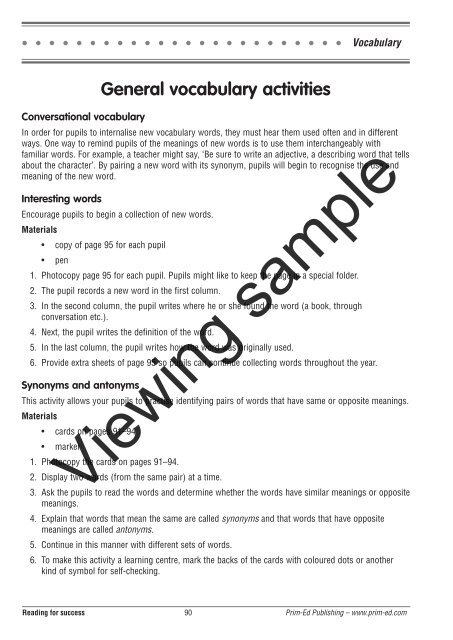PR-6218UK Reading for Success - Book 3
You also want an ePaper? Increase the reach of your titles
YUMPU automatically turns print PDFs into web optimized ePapers that Google loves.
Vocabulary<br />
Conversational vocabulary<br />
General vocabulary activities<br />
In order <strong>for</strong> pupils to internalise new vocabulary words, they must hear them used often and in different<br />
ways. One way to remind pupils of the meanings of new words is to use them interchangeably with<br />
familiar words. For example, a teacher might say, ‘Be sure to write an adjective, a describing word that tells<br />
about the character’. By pairing a new word with its synonym, pupils will begin to recognise the use and<br />
meaning of the new word.<br />
Interesting words<br />
Encourage pupils to begin a collection of new words.<br />
Materials<br />
• copy of page 95 <strong>for</strong> each pupil<br />
• pen<br />
1. Photocopy page 95 <strong>for</strong> each pupil. Pupils might like to keep the page in a special folder.<br />
2. The pupil records a new word in the first column.<br />
3. In the second column, the pupil writes where he or she found the word (a book, through<br />
conversation etc.).<br />
4. Next, the pupil writes the definition of the word.<br />
5. In the last column, the pupil writes how the word was originally used.<br />
6. Provide extra sheets of page 95 so pupils can continue collecting words throughout the year.<br />
Synonyms and antonyms<br />
This activity allows your pupils to practise identifying pairs of words that have same or opposite meanings.<br />
Materials<br />
• cards on pages 91–94<br />
• marker<br />
1. Photocopy the cards on pages 91–94.<br />
2. Display two words (from the same pair) at a time.<br />
3. Ask the pupils to read the words and determine whether the words have similar meanings or opposite<br />
meanings.<br />
4. Explain that words that mean the same are called synonyms and that words that have opposite<br />
meanings are called antonyms.<br />
5. Continue in this manner with different sets of words.<br />
6. To make this activity a learning centre, mark the backs of the cards with coloured dots or another<br />
kind of symbol <strong>for</strong> self-checking.<br />
Viewing sample<br />
<strong>Reading</strong> <strong>for</strong> success 90 Prim-Ed Publishing – www.prim-ed.com


















